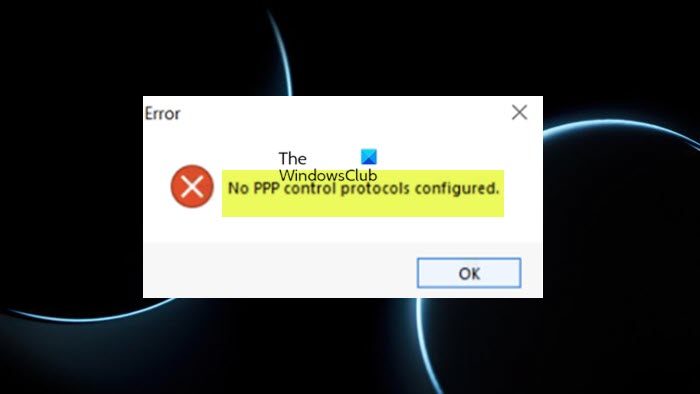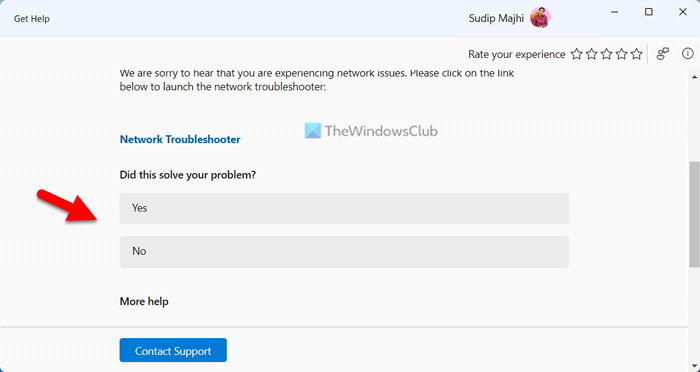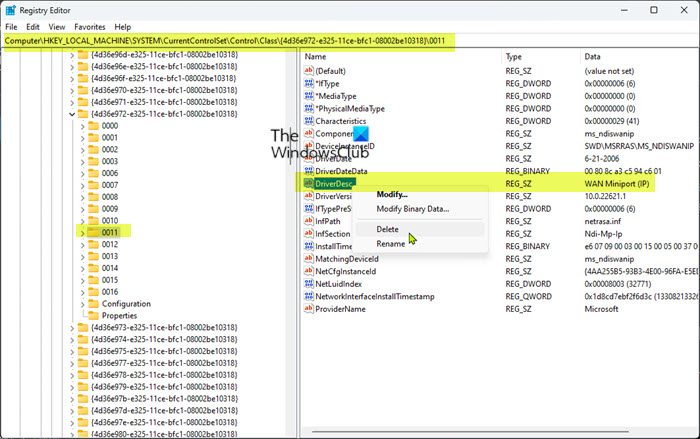When you try to connect to the Internet with a dial-up connection or to establish a VPN connection to Windows RRAS on a Windows 11/10 client machine, you may receive the error message No PPP control protocols configured or similar, but typically accompanied by the error code 720. This post offers practical solutions to the issue.

When this issue occurs on your system, you may receive one of the following error messages:
- Error 720: No PPP Control Protocols configured.
- Error 720: Dial-Up networking could not negotiate a compatible set of network protocols you specified in the Server Type settings. Check your network configuration in the network control panel and try the connection again.
- Error 720: The connection attempt failed because your computer and the remote computer could not agree on the PPP control protocol.
You’re likely to encounter this issue due to the following reasons:
- TCP/IP is damaged or is not bound to your dial-up adapter.
- The client computer and the RAS server do not have a protocol in common, or RAS is not configured correctly.
- The client’s VPN server gets the DHCP to assign IP to the VPN client.
- WAN Miniport issue.
- MS-CHAP version issue.
Read: WAN Connection Error on Windows PC
Error 720: No PPP control protocols configured
Suppose the No PPP control protocols configured with error code 720 occur when trying to connect to the Internet with a dial-up connection or when attempting to establish a VPN connection to Windows RRAS on a Windows 11/10 client machine. In that case, the fixes we have presented below in no particular order can be applied to resolve the issue.
- Initial checklist
- Configure PPTP to use PEAP-MS-CHAP v2 for authentication
- Uninstall/Reinstall the TCP/IP Protocol
- Contact your Internet Service Provider (ISP)
Let’s look at the description of the process as it relates to each of the listed solutions.
Read: VPN Error 721: The remote computer is not responding
1] Initial checklist

Essentially, the basic troubleshooting for the No PPP control protocols configured with error code 720 on your Windows 11/10 client machine requires you to do the following:
- Check the settings of the router or modem to make sure that the router is configured to use the Point-to-Point Protocol (PPP).
- Check the settings of the client computer to make sure that the computer is configured to use the Point-to-Point Protocol (PPP).
- Check the cables to make sure that all cables are securely connected and that there are no loose connections.
- Check the drivers to make sure that all drivers are updated especially network adapter drivers.
- Make sure the modem and router are up to date. You can search the instructions for your router firmware update procedure through the support website offered by your device manufacturer using the exact model number to update your router’s firmware.
- Run the Network and Internet Troubleshooter.
- Create an IP pool to assign IP to the VPN client or use Windows DHCP instead of the router as DHCP.
- Reset Network to reinstall network adapters and reset networking components to default. Once done, you can re-configure or set up your dial-up or VPN connection again with the required settings.
- Reset the modem and router to factory settings. For most modern routers (refer to the device user manual), doing a complete factory reset involves only a few steps.
Read: Connection between access point, router, and the Internet is broken
2] Configure PPTP to use PEAP-MS-CHAP v2 for authentication
This solution requires you to configure PPTP to use PEAP-MS-CHAP v2 for authentication. Microsoft recommends Protected Extensible Authentication Protocol (PEAP) with MS-CHAP v2 as the client authentication method is one way to help secure VPN authentication.
To enforce the use of PEAP on client platforms, Windows Routing and Remote Access Server (RRAS) servers should be configured to allow only connections that use PEAP authentication, and to refuse connections from clients that use MS-CHAP v2 or EAP-MS-CHAP v2. Administrators must confirm the following and also check the corresponding authentication method options on the RRAS server and the Network Policy Server (NPS) server.
- Server certificate validation is turned ON. (The default behavior is ON.)
- Server Name validation is turned ON. (The default behavior is ON.) The correct server’s name must be specified.
- The root certificate from which the Server certificate was issued is installed correctly on the client system’s store and is turned ON. (Always ON).
- On the Windows client machine, the Do not prompt the user to authorize new servers or trusted certification authorities option in the PEAP properties window should be enabled. By default, it is disabled.
To configure the RRAS Server for the PEAP-MS-CHAP v2 authentication method, follow the steps shown below:
- In the RRAS Server Management window, open Server Properties.
- Click the Security tab.
- Click Authentication Methods.
- Now, make sure that the EAP check box is selected and that the MS-CHAP v2 check box is not selected.
Once done, you can proceed to configure connections for Network Policy Server to only allow connections from clients that use the PEAP-MS-CHAP v2 authentication method by following the steps below. To configure this connection, a valid Server certificate must be installed in the Personal store, and a valid root certificate must be installed in the Trusted Root CA store of the server.
- Open the NPS UI.
- Click Policies.
- Click Network Policies.
- Right-click Connections to Microsoft Routing and Remote Access Server, and then select Properties.
- On the Properties dialog, click the Constraints tab.
- In the left Constraints pane, select Authentication Methods.
- Uncheck the boxes for the MS-CHAP and MS-CHAP-v2 methods.
- Next, remove EAP-MS-CHAP v2 from the EAP Types list.
- Next, click Add.
- Select the PEAP authentication method.
- Click OK.
- Next, click Edit.
- Select EAP-MS-CHAP v2 as the authentication method.
Read: The requested certificate template is not supported by this CA
Once done, you can now proceed to configure the Windows VPN clients to use the PEAP-MS-CHAP v2 authentication method by selecting the corresponding method from the VPN connection properties UI and by installing the appropriate root certificate on the client system. To perform this task, do the following:
- Press the Windows key + R to invoke the Run dialog.
- In the Run dialog box, type ncpa.cpl and hit Enter to open the Network Connections folder.
- Under Virtual Private Network, right-click the VPN connection, and then click Properties.
- Next, click the Networking tab.
- Now, make sure that you have a protocol that the RAS server is running.
If you do not have a protocol that the RAS server is running, follow the steps below to add the needed protocol:
- Click Install.
- Click Protocol.
- Click Add.
- Click the protocol that you need to install.
- Click OK.
Read: PPTP/L2TP VPN is not connecting in Windows 11
4] Uninstall/Reinstall the TCP/IP Protocol
When this error occurs on your Windows 11/10 client computer, if you view the devices in Device Manager, you may notice a yellow exclamation mark (!) over the icon for the WAN Miniport IP (#2) device. In this case, to resolve the issue, you will need to uninstall the TCP/IP protocol, remove the second WAN Miniport IP device, and then reinstall the TCP/IP protocol.
Do the following:
- Open the Network Connections folder.
- Right-click the Local Area Connection network adapter, and then click Properties.
- Under the This connection uses the following items section, click Internet Protocol (TCP/IP).
- Click the Uninstall button.
- Follow the on-screen instructions to uninstall TCP/IP.
- Restart the computer when prompted but click No if you are prompted to allow Windows to enable a protocol.
- Next, open Device Manager.
- On the View menu, click Show hidden devices.
Under Network adapters, there should be no WAN Miniport IP devices. If a WAN Miniport IP device is listed, continue to the following step. If no WAN Miniport IP device is listed, go directly to the part below for the steps to reinstall the TCP/IP protocol. Since this is a registry operation, it is recommended that you back up the registry or create a system restore point as necessary precautionary measures. Once done, you can proceed as follows:

- Press Windows key + R to invoke the Run dialog.
- In the Run dialog box, type regedit and hit Enter to open Registry Editor.
- Navigate or jump to the registry key path below:
HKEY_LOCAL_MACHINE\SYSTEM\CurrentControlSet\Control\Class\{4D36E972-E325-11CE-BFC1-08002BE10318}
At the location, click each of the registry subkeys under this GUID key, and then view the Data column of the DriverDesc value to determine which of the subkeys corresponds to WAN Miniport (IP).
- Once identified, right-click the subkey whose DriverDesc value data is WAN Miniport (IP), and then click Delete.
- Click Yes to confirm that you want to delete the key.
- Exit Registry Editor.
- Now, go back to Device Manager, under the Network adapter section, and uninstall the WAN Miniport (IP) device.
Now, to reinstall the TCP/IP protocol, follow these steps:
- In the Network Connections folder, right-click Local Area Connection network adapter, and then click Properties.
- Click Install.
- In the Select Network Component Type dialog box, click Protocol.
- Click Add.
- Under Network Protocol, click Internet Protocol (TCP/IP).
- Click OK.
- Click Close when the protocol is installed.
Now, reset the modem by turning the power off and then on, or for an internal modem, restart the computer. Test your Internet connectivity and see if your problem is resolved. Else, proceed with the next suggestion.
5] Contact your Internet Service Provider (ISP)
This solution applies specifically to affected users that encountered the issue using a dial-up internet connection. This requires you to contact your ISP to ensure they provide the correct settings for your connection.
Read: Error 633: The modem is already in use or is not configured
Hopefully, this helps!
What is the PPP link control protocol was terminated?
This error is usually associated with the error code 734 and it indicates you have a Multi-link negotiation turned on for a single-link connection, or have the dial-up connection security configuration improperly configured to the Require secured password option. If you have encountered this error, to resolve the issue, you can refer to the linked guide in this post above.
Related post: The PPP link control protocol was terminated — Error 734
How do I fix no PPP control protocols configured?
If you have received this error message on your Windows 11/10 computer, to fix the error, we have provided adequate solutions and suggestions in this post above to help you. PPP error means that the computer was unable to establish a connection to the internet. The Point-to-Point Protocol is essentially a set of instructions that are used by two or more computers over a serial interface, such as a dial-up connection.
Read next: Fix VPN Error 691, The remote connection was not made or denied.
Leave a Reply